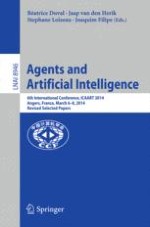2015 | Book
Agents and Artificial Intelligence
6th International Conference, ICAART 2014, Angers, France, March 6-8, 2014, Revised Selected Papers
Editors: Béatrice Duval, Jaap van den Herik, Stephane Loiseau, Joaquim Filipe
Publisher: Springer International Publishing
Book Series : Lecture Notes in Computer Science
